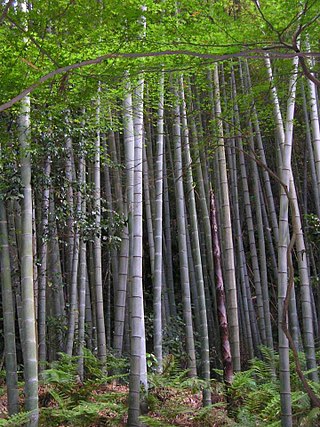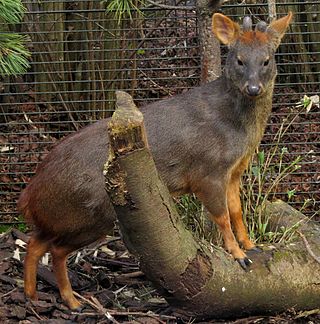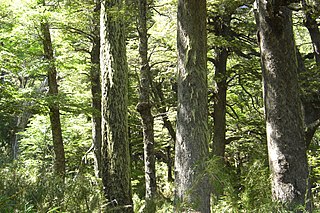
Bamboos are a diverse group of mostly evergreen perennial flowering plants making up the subfamily Bambusoideae of the grass family Poaceae. Giant bamboos are the largest members of the grass family, in the case of Dendrocalamus sinicus individual culms reaching a length of 151 feet, up to fourteen inches in thickness and a weight of up to 990 pounds. The internodes of bamboos can also be of great length. Kinabaluchloa wrayi has internodes up to 8.2 feet in length. and Arthrostylidium schombergkii with lower internodes up to 16 feet in length, exceeded in length only by Papyrus. By contrast, the culms of the tiny bamboo Raddiella vanessiae of the Kaieteur Plateau in French Guiana are only 0.4–0.8 inches in length by about one-twelfth inch in width. The origin of the word "bamboo" is uncertain, but it probably comes from the Dutch or Portuguese language, which originally borrowed it from Malay or Kannada.

Araucaria araucana, commonly called the monkey puzzle tree, monkey tail tree, piñonero, pewen or Chilean pine, is an evergreen tree growing to a trunk diameter of 1–1.5 m (3.3–4.9 ft) and a height of 30–40 m (98–131 ft). It is native to central and southern Chile and western Argentina. It is the hardiest species in the conifer genus Araucaria. Because of the prevalence of similar species in ancient prehistory, it is sometimes called a living fossil. It is also the national tree of Chile. Its conservation status was changed to Endangered by the IUCN in 2013 due to the dwindling population caused by logging, forest fires, and grazing.

Cortaderia is a genus of South American and Central American plants in the Poaceae grass family.

The Valdivian temperate forests (NT0404) is an ecoregion on the west coast of southern South America, in Chile and Argentina. It is part of the Neotropical realm. The forests are named after the city of Valdivia. The Valdivian temperate rainforests are characterized by their dense understories of bamboos, ferns, and for being mostly dominated by evergreen angiosperm trees with some deciduous specimens, though conifer trees are also common.

Chusquea is a genus of evergreen bamboos in the grass family. Most of them are native to mountain habitats in Latin America, from Mexico to southern Chile and Argentina.

Guadua is a Neotropical genus of thorny, clumping bamboo in the grass family, ranging from moderate to very large species.

Phyllostachys aureosulcata, the yellow groove bamboo, is a species of bamboo native to the Zhejiang Province of China. It is a running bamboo with a distinctive yellow stripe in the culm groove that is often grown as an ornamental.

Bambusa vulgaris, common bamboo, is an open-clump type bamboo species. It is native to Indochina and to the province of Yunnan in southern China, but it has been widely cultivated in many other places and has become naturalized in several regions. Among bamboo species, it is one of the largest and most easily recognized.

Bamboo blossoming is a natural phenomenon in which the bamboos in a location blossom and become hung with bamboo seeds.

Chusquea culeou, the Chilean bamboo, is a species of flowering plant in the grass family Poaceae. An evergreen bamboo native to South America, unlike most species within the genus Chusquea, it is frost-tolerant and thus widely cultivated in temperate regions.

The Chiloé Archipelago is a group of islands lying off the coast of Chile, in the Los Lagos Region. It is separated from mainland Chile by the Chacao Channel in the north, the Sea of Chiloé in the east and the Gulf of Corcovado in the southeast. All islands except the Desertores Islands form Chiloé Province. The main island is Chiloé Island. Of roughly rectangular shape, the southwestern half of this island is a wilderness of contiguous forests, wetlands and, in some places, mountains. The landscape of the northeastern sectors of Chiloé Island and the islands to the east is dominated by rolling hills, with a mosaic of pastures, forests and cultivated fields.
Abrothrix olivacea, also known as the olive grass mouse or olive akodont, is a species of rodent in the genus Abrothrix of family Cricetidae. It is found from northern Chile into southern Chile and Argentina, including the islands of Tierra del Fuego. It is prone to large swings in population size.

Oligoryzomys longicaudatus, also known as the long-tailed colilargo or long-tailed pygmy rice rat, is a species of rodent in the genus Oligoryzomys of the family Cricetidae. It is found in the southern Andes of Chile and Argentina, with an outlying population in eastern Argentina. As a common species with a wide range and a stable population, the International Union for Conservation of Nature has rated this rodent as being of "least concern".

The southern pudu is a species of South American deer native to the Valdivian temperate forests of south-central Chile and adjacent Argentina. It is classified as Near Threatened in the IUCN Red List.

Phyllostachys edulis, the mōsō bamboo, or tortoise-shell bamboo, or mao zhu, , is a temperate species of giant timber bamboo native to China and Taiwan and naturalised elsewhere, including Japan where it is widely distributed from south of Hokkaido to Kagoshima. The edulis part of the Latin name refers to its edible shoots. This bamboo can reach heights of up to 28 m (92 ft). This particular species of bamboo is the most common species used in the bamboo textile industry of China and other countries, for the production of rayon. Moso is less cold-hardy than many phyllostachys, surviving at a reduced height down to 5 degrees Fahrenheit (-15°C).

Bamboo shoots or bamboo sprouts are the edible shoots of many bamboo species including Bambusa vulgaris and Phyllostachys edulis. They are used as vegetables in numerous Asian dishes and broths. They are sold in various processed shapes, and are available in fresh, dried, and canned versions.

Dendrocalamus asper, also known as giant bamboo or dragon bamboo, is a giant, tropical, clumping species of bamboo native to Southeast Asia. In addition to its prolific nature across Asia, the plant's overall attractive appearance has seen this species introduced widely across South America and Africa, as well as Mexico and Florida. One advantage of this bamboo, especially for gardens, is its natural growth habit as a sympodial, colony-forming plant. Overall this bamboo maintains its own "personal" growing space, and does not grow laterally (runners), thus posing less risk of being environmentally-invasive.
Dendrocalamus giganteus, commonly known as giant bamboo, is a giant tropical and subtropical, dense-clumping species native to Southeast Asia. It is one of the largest bamboo species in the world.
Melocanna baccifera is one of two bamboo species belonging to the Melocanna genus. It grows up to 10–25 m tall. It is native to Bangladesh, Myanmar, India, and Thailand.

Bosque Andino Patagónico, also known as Patagonian Andean forest, is a type of temperate to cold forest located in southern Chile and western Patagonia in Argentina at the southern end of South America. The climate here is influenced by humid air masses moving in from the Pacific Ocean which lose most of their moisture as they rise over the Andes. The flora is dominated by trees, usually of the genus Nothofagus.
















